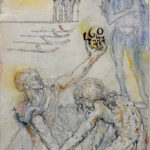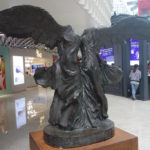Salvador Dali (Spanish, 1904-1989)
“Winged Triton” (c. 1972)
Edition of 199.
78cm x 77cm x 43cm (including base).
Literature: Catalogue Raisonne “Le Dur et le Mou” by Robert & Nicolas Descharnes, pg. 164-165, Ref #413.
Present value: $50,000.
PRICE: Upon Request.
P.E. casts of the 78 x 77 x 43 cm edition are part of the permanent collections of the Spurlock Museum (Illinois, USA) and of the Memorial Art Gallery (New York, USA).
In mythology, charitable half-god who comes from the depths of the sea, on occasions he is also bloodthirsty. According to the legend, Triton used to appear above the waters to calm the waves and lull the storms.
Did Triton ever emerge from the deep waters at Cape Creus? Did Dali ever see him all powerful conquering the forces of nature? This thought comes to our mind when we see how many drawings are conserved in which the painter, with raised hand, drew various silhouettes of Neptune’s son.
Salvador Dali (Spanish, 1904-1989)
“Gala Gradiva” (c. 1970)
Edition of 99.
89.5cm (including base).
Literature: Catalogue Raisonne “Le Dur et le Mou” by Robert & Nicolas Descharnes, pg. 170, Ref #430.
Present value: $50,000.
PRICE: Upon Request
A P.E. cast of the 89,5 x 48 x 45 cm edition is part of the permanent collection of the Butler Institute of American Art (Ohio, USA).
After having read Freud’s analysis of W. Jensen’s Gradiva, Dali recognized Gala as his Gradiva and, like Hanold, the main character of Jensen’s story, “He was unable to explain what it was in her that aroused his interest; he only knew that from the first moment he had felt dominated by an intense attraction which time did not succeed in weakening”.
“as she walks, she gathers up her flowing garments, revealing her sandaled feet, one of which rests completely on the ground, whilst with the other she is on tiptoes, the sole and ankle almost perpendicular to the earth. This pose is not at all usual and the artist wished to place it in his sculptural work because of the special attraction it produces.” Sigmund Freud on “Gradiva” by W. Jensen.
Salvador Dali (Spanish, 1904-1989)
“Carmen Castanets” (c. 1970)
Edition of 199.
70cm (including base).
Literature: Catalogue Raisonne “Le Dur et le Mou” by Robert & Nicolas Descharnes, pg. 174-175, Ref #445.
Present value: $50,000.
PRICE: Upon Request.
Beautiful Spaniard woman archetype performing a Flamenco dance. Carmen is depicted as the beautiful and wild gypsy dancing to the sound of the castanets which she holds between her fingers. Seducing the watcher in the same way Merimee’s heroine seduced all men around her.
Prosper Merimée said of his leading character in Carmen that she spoke Basque and exerted a maddening effect on men that eventually lead her to destruction. This novel, published in 1845, quickly became the stereotype of Spanish women: free, fiery, superstitious, proud and wild, provoking uproar in the society of the time which demanded the exact opposite of women: virtue and maternity, laboriousness, obedience and submission.

Salvador Dali (Spanish, 1904-1989)
“Winged Triton” (c. 1972)
Edition of 199.
78cm x 77cm x 43cm (including base).
Literature: Catalogue Raisonne “Le Dur et le Mou” by Robert & Nicolas Descharnes, pg. 164-165, Ref #413.
Present value: $50,000.
PRICE: $29,500. USD
(Usually offered at $40,000. Only ONE at this price!)
|
P.E. casts of the 78 x 77 x 43 cm edition are part of the permanent collections of the Spurlock Museum (Illinois, USA) and of the Memorial Art Gallery (New York, USA). |
|||||
|
|
|||||
|
In mythology, charitable half-god who comes from the depths of the sea, on occasions he is also bloodthirsty. According to the legend, Triton used to appear above the waters to calm the waves and lull the storms. |
|||||
|
|
|||||
|
Did Triton ever emerge from the deep waters at Cape Creus? Did Dali ever see him all powerful conquering the forces of nature? This thought comes to our mind when we see how many drawings are conserved in which the painter, with raised hand, drew various silhouettes of Neptune’s son.
“Gala Gradiva”
Salvador Dali (Spanish, 1904-1989) “Gala Gradiva” (c. 1970) Edition of 99. 89.5cm (including base). Literature: Catalogue Raisonne “Le Dur et le Mou” by Robert & Nicolas Descharnes, pg. 170, Ref #430. Present value: $50,000. PRICE: $29,500. USD (Usually offered at $40,000. Only ONE at this price!)
|

Salvador Dali (Spanish, 1904-1989)
“Carmen Castanets” (c. 1970)
Edition of 199.
70cm (including base).
Literature: Catalogue Raisonne “Le Dur et le Mou” by Robert & Nicolas Descharnes, pg. 174-175, Ref #445.
Present value: $50,000.
PRICE: $29,500. USD
(Usually offered at $40,000. Only ONE at this price!)
|
Beautiful Spaniard woman archetype performing a Flamenco dance. Carmen is depicted as the beautiful and wild gypsy dancing to the sound of the castanets which she holds between her fingers. Seducing the watcher in the same way Merimee’s heroine seduced all men around her. |








